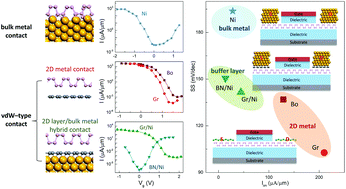Black phosphorus transistors with van der Waals-type electrical contacts†
Abstract
Contact engineering is a possible solution to decrease the pervasive Schottky barrier in a two dimensional (2D) material transistor with bulk metal electrodes. In this paper, two kinds of typical van der Waals (vdW)-type electrical contacts (a 2D metal contact and a 2D material/bulk metal hybrid contact) in monolayer (ML) black phosphorus (BP) transistors are investigated by ab initio energy band calculations and quantum transport simulations. Compared with the traditional bulk metal Ni contact, the gate electrostatic control is significantly improved by using both 2D graphene and borophene electrodes featuring a decrease of 30–50% in the subthreshold swing and an increase by a factor of 4–7 in the on-state current due to the depressed metal induced gap states and reduced screening of the 2D metal electrodes to the gate. In contrast, graphene insertion between the Ni electrode and ML BP shows only a slight improvement in the gate electrostatic control ability and BN insertion shows almost no improvement. The higher efficiency using the 2D metal contact than the 2D material/bulk metal hybrid contact in improving the ML BP FET device performance also provides helpful guidance in the selection of vdW-type electrical contacts of other 2D transistors.

- This article is part of the themed collection: 2017 Nanoscale HOT Article Collection


 Please wait while we load your content...
Please wait while we load your content...